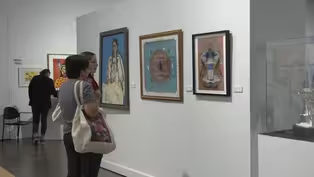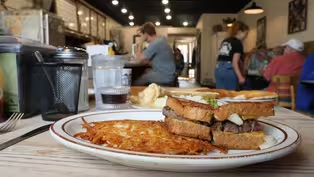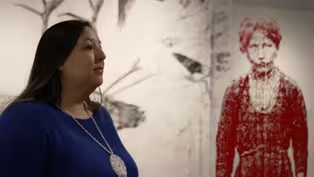
Honoring Howe: Legacy of Stories
Clip: Season 15 Episode 5 | 9m 32sVideo has Closed Captions
Wicanhpi Iyotan Win (Autumn Cavender) talks about the legacy of artist Oscar Howe.
Wicanhpi Iyotan Win (Autumn Cavender) talks about the history and legacy of artist Oscar Howe and how her art installation was created in his honor.
Problems playing video? | Closed Captioning Feedback
Problems playing video? | Closed Captioning Feedback
Postcards is a local public television program presented by Pioneer PBS
Production sponsorship is provided by contributions from the voters of Minnesota through a legislative appropriation from the Arts and Cultural Heritage Fund, Explore Alexandria Tourism, Shalom Hill Farm, Margaret A. Cargil Foundation, 96.7kram and viewers like you.

Honoring Howe: Legacy of Stories
Clip: Season 15 Episode 5 | 9m 32sVideo has Closed Captions
Wicanhpi Iyotan Win (Autumn Cavender) talks about the history and legacy of artist Oscar Howe and how her art installation was created in his honor.
Problems playing video? | Closed Captioning Feedback
How to Watch Postcards
Postcards is available to stream on pbs.org and the free PBS App, available on iPhone, Apple TV, Android TV, Android smartphones, Amazon Fire TV, Amazon Fire Tablet, Roku, Samsung Smart TV, and Vizio.
Providing Support for PBS.org
Learn Moreabout PBS online sponsorship- Coming from a very Dakota perspective on art, and what art is, if art is not telling a story, then I don't really believe that it's art.
(traditional drum playing) (singers singing in Lakota) Oscar Howe is arguably the most famous contemporary Dakota artist, certainly the most famous Dakota artist of the 20th century.
And on this, this kind of major anniversary of his passing, this exhibit was put together as a satellite exhibit to the Dakota Modern Exhibit that toured in between Portland, the Museum of the American Indian, and then the Museum of South Dakota and Brookings.
And so this satellite exhibit is really about the legacy of Oscar Howe as it relates generationally to Indigenous artists, specifically Dakota artists in our own home territories.
(slow relaxing music) The legacy of Oscar Howe really is unparalleled in Native American art, because he was one of the first people to really, truly articulate, and put to words the contemporary nature of American Indian artwork.
He was one of the first people to draw a very, very firm line academically to say that there is no differentiation between modern art, and ancestral art or traditional Indian art, that they are one in the same, they come from the same tradition, and that our cultures are dynamic, and moving, and constantly integrating new information and new mediums, and so that the art that he produced over the course of his life was no less traditional than something that you would see in a museum about Native American people.
(slow relaxing music) Oscar Howe himself is Dakota, and specifically he was born and is from the Crow Creek Reservation here in South Dakota.
The story of the, the founding of Crow Creek Reservation is actually rooted in the US Dakota War of 1862 because all of the prisoners of war, all of the concentration camp survivors, all of the survivors of the concentration camp in Davenport, Iowa, were all congregated and shipped by rail and by boat out to Crow Creek, South Dakota, to the military fort located there, and really, they were sent there to die.
The descendants of those survivors, those concentration camp survivors who were sent to this place, those are the people from whom Oscar Howe originated.
Those were his grandparents.
Indeed, his grandmother, Shell Face, would tell him stories about the way that she survived battles that took place in Minnesota prior to her exile, and so if we're talking about Oscar Howe's legacy, it begins in Minnesota, because that is how he ended up here.
It begins with the war in 1862, because that's how he ended up here.
And it begins with the survival of his grandmother when her older brother placed her on a white horse and told her to ride and not look back.
When we carry those kinds of historical stories with us, it becomes real, it's tangible, it's something we can hold in our hands.
It's something we can see on wall through these paintings.
But they're no longer dry stories in a history book, right?
This isn't some abstract survivor of some battle that happened 150 years ago.
This is Oscar Howe's grandmother who was shot through the hand when she fled, and the bullet passed through her hand and into the horse.
And after a night of riding, that horse finally died after it got her to safety, (uptempo dramatic music) Oscar Howe was seen as this kind of rags to riches Indian story, a successful assimilationist story.
Here is a native person who became a soldier, who then went through the GI Bill, and became a successful artist and a college professor.
Isn't this such an exceptional Indian story?
And that was often how it was framed over the course of his life, but the actual legacy of who he was as an artist and a person has far transcended that and really pushed the narrative of what success means as a native person within contemporary colonial society.
For me, Oscar Howe is this kind of very subconscious foundation to what I believe good aesthetic art to be?
(uptempo dramatic music) This is actually in some ways two pieces.
You have the first part, which is the main installation.
It's the part we're sitting on, and this part is called the House of the Skin Painters.
The idea of the skin painter is something that came up repeatedly in Howe's work as the people who carried on history, who carried on Dakota aesthetic and design work.
This idea of being here is really about potentiality, right?
What hasn't been made yet, and even the idea of projecting on the hide rather than painting on it, rather than putting something permanent on it, reflects that transience that actually brings us to Iyun Woihanbde or Paint Dreaming, which is the name of the video that's being projected onto the hide.
And so this video is actually utilizing a combination of ancestral intelligence and synthetic intelligence instead of artificial to take work of Oscar Howe and to train these different artificial intelligences, these different synthetic intelligences on these images, and insert in them ancestral knowledge, insert in them historical, and contemporary images of Dakota art and co-create along with this thing that we can now use as a tool to both talk to, you know, talk to ancestors, right?
In an active conversation of the modern and the ancient through this means of synthetic intelligence, through synthetic technology, which for me is super exciting and super cool.
This itself is actually a rendition of Oscar Howe's paintings of skin painters painting.
And so some of the other geometrics that you see on the hide are very similar to that (slow relaxing music) As these images shift and as they burn away, and come back, and shuffle in, and glitch in.
It's this kind of on running idea of these are the dreams that we have prior to putting a brush to paper, prior to putting a brush to skin.
For me it was also a really interesting reflection on Oscar Howe himself, and the legacy of it.
He's now one of our collective ancestors that we draw on for information, we draw on them for inspiration for our work.
You know, he's one of our collective whole of people that we call upon.
The only narrative we ever hear is that Indigenous art is something that exists in the past, is a museum piece, and is consistently relegated to the subsection of history rather than living and moving forward.
It means that we ourselves don't really have a future because we don't have a present.
Imagining ourselves in the present through contemporary art and telling our stories of both our contemporary past and potential future realities through these mediums helps us imagine ourselves moving forward.
It helps us imagine a future in which we continue to exist.
(uptempo electronic music) - [Announcer] "Postcards" is made possible by the Minnesota Arts and Cultural Heritage Fund and the citizens of Minnesota.
Additional support provided by Margaret A. Cargill Philanthropies, Mark and Margaret Yackel-Juleen on behalf of Shalom Hill Farms, a retreat and conference center in a prairie setting near Windom, Minnesota.
On the web at shalomhillfarm.org.
Alexandria, Minnesota, a year-round destination with hundreds of lakes, trails.
and attractions for memorable vacations and events.
More information at explorealex.com, the Lake Region Arts Councils Arts Calendar, an arts and cultural heritage funded digital calendar, showcasing upcoming art events and opportunities for artists in West Central Minnesota.
On the web at lrac4calendar.org.
Playing today's new music plus your favorite hits, 96 7 CRA.
Online at ninetysixseven.com.
(upbeat music)
Community Cafe, Artist, Art Exhibit
Preview: S15 Ep5 | 40s | Frieda's Cafe; honoring Oscar Howe w/ artist Wicanhpi Iyotan Win; and a joint art exhibit. (40s)
Video has Closed Captions
Clip: S15 Ep5 | 10m 1s | Frieda's Cafe in Willmar began as a WWII refugee story and continues to serve. (10m 1s)
Video has Closed Captions
Clip: S15 Ep5 | 11m 11s | The American Swedish Institute & All My Relations Arts present an art exhibit. (11m 11s)
Providing Support for PBS.org
Learn Moreabout PBS online sponsorshipSupport for PBS provided by:
Postcards is a local public television program presented by Pioneer PBS
Production sponsorship is provided by contributions from the voters of Minnesota through a legislative appropriation from the Arts and Cultural Heritage Fund, Explore Alexandria Tourism, Shalom Hill Farm, Margaret A. Cargil Foundation, 96.7kram and viewers like you.
























